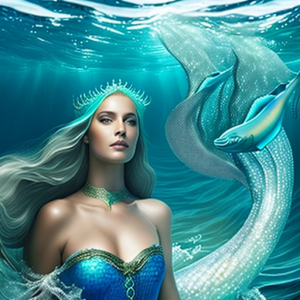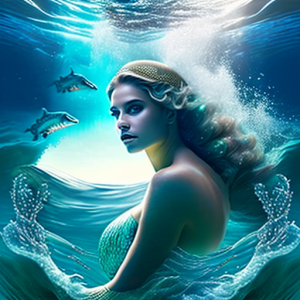History of creation
The fairy tale “The Little Mermaid” was written in 1837 and was included in the collection “Fairy Tales Told for Children”. This is one of Andersen’s most popular fairy tales, based on which many cartoons and films have been shot. The little mermaid statue has become a symbol of Copenhagen.
In the first edition, the tale ended with the death of the little mermaid, who turned into sea foam. In this version, the fairy tale is more like a romantic story, in it the outcast heroine dies. But for Andersen, the Christian component of the tale is very important. The possibility of the little mermaid, who has turned into one of the daughters of the air, to find an immortal soul, even after 300 years, is a happy fairy tale end, it is much better than 300 years of life as a mermaid.
Literary direction and genre
The fairy tale “The Little Mermaid” reminds the plot of a fairy tale in which the hero, with the help of magic objects and assistants, reaches his goal, and usually ends with a wedding. But the wedding does not take place in the fairy tale, and it becomes clear that the main goal of the little mermaid is not to marry the prince, but to find an immortal soul. In this sense, the fairy tale has a good end, because the little mermaid has hope. This twist of the plot brings the fairy tale closer to the parable, besides, at the end there is a hidden lesson for young readers: if the children are worthy of their parents and delight them, then the test period for the daughters of the air is reduced. Such direct moralizing was not characteristic of the 19th century works. and criticized by reviewers.
The little mermaid is a real romantic heroine. Unlike other marine inhabitants, she feels a stranger in a calm underwater kingdom and dreams of living among people. The little mermaid longs for a high, unusual one; she is ready to make any sacrifices for this and even sacrifice herself.
Subject, main idea and problems
The theme of the tale is the goal of human life. The little mermaid is not a person, although she is very similar to him. And the point is not in the fish tail, but in the fact that she, as a child reader, wants to be good, but she goes to her goal intuitively, stumbling and making mistakes. One after another, she rejects life values: family, peace and wealth, family ties, duty. It seems that the main life goal of the little mermaid is love. Perhaps this is true, but the little mermaid refuses conjugal happiness after learning sacrificial love. Maybe that’s why she does not die, but turns into one of the daughters of the air. The main idea of the tale is that the immortal soul is worth any earthly suffering, long days of hard life.
The main problem of a children’s fairy tale is religious-philosophical, but it is precisely for solving such problems that fairy tales exist. The tale also raises psychological problems. The reader observes how the mermaid is filled with conflicting feelings and emotions towards the prince and his wife, how she copes with them.
The plot and composition
The tale begins with a description of the underwater kingdom and the palace of the sea king, where the little mermaid lived. Andersen emphasizes that the underwater world is different from the earth: there are other plants and animals, other inhabitants and orders. This is the “other world”, the “far-away kingdom” of the fairy tale, the place where the souls of the dead dwell. No wonder people can get into this world only dead.
The underwater kingdom is a converted and distorted earthly world. His laws parody the earthly. For example, nobles as a mark of distinction can carry six oysters on their tail, and the Dowager Queen, contrary to the law, wears a dozen (12). The inhabitants of the underwater kingdom imitate people, strive to be like them. Six princesses decorate their flower beds with what falls from the ships. Grandmother tells her granddaughters about life on earth in the same way as grandmothers tell fairy tales about magical worlds to our children.
The world of a fairy tale often reflects the rite of initiation – growing up a hero. That is why the hero or heroine fall into the underwater or underground world (the world of ancestors) and undergo a series of tests there, after which they are considered adults. In the underwater kingdom, 15-year-old mermaids, on the contrary, first get to the surface of the sea and get acquainted with the world of people. Obviously, this is done so that they realize that, although the earthly world is attractive and interesting, their world is more familiar and calmer: “Everywhere is good, and home is better.” This conclusion is made by 5 older sisters, but not the little mermaid.
She falls in love with the prince at first sight and saves him during a shipwreck. The little mermaid is experiencing her first disappointment, because the prince does not know who his savior is.
After learning from her grandmother that the mermaid can find an immortal soul, the mermaid decides to turn to the sea witch. All her misfortunes begin with the fact that she misunderstands the words of her grandmother. She hears what she wants to hear, because she should not have loved the prince more than her father and mother, but he her! The little mermaid makes a false conclusion that the suffering suffered will give her an immortal soul.
To gain a soul, the little mermaid goes through a series of tests. She is in danger along the way to the sea witch’s house: seething whirlpools, bubbling silt, which the witch called the peat bog, strangling polyps. The little mermaid gets a magic drink that will make her a beautiful girl, but she pays a double price: she gives a beautiful voice to the witch, and together with her beautiful legs she gets pain, steps “like with sharp knives”.
It turns out that instead of one, the mermaid, the mermaid receives another gift, instead of the ability to sing, the ability to dance like no one else has danced. But the same gift gives her unbearable physical suffering, which is only a shadow of mental suffering. Having survived the trials that fell to her lot with honor, the little mermaid does not die, but turns into one of the daughters of the air. This is not only a transition to another physical state (watery became airy), but also approaching the true goal – the immortal soul, which the former mermaid can earn after 300 years.
Heroes
Mermaids are the daughters of the sea king, but Andersen himself called his underwater heroines sea virgins.
His heroines have something in common with sirens, whose voices were heard by sailors and, having sailed closer, were breaking on rocks. The word “little mermaid” appeared when translated into Russian. Indeed, the “little sea maiden” sounds monstrous, and the mermaids are creatures of Slavic mythology, albeit with different qualities.
The main character, the little mermaid, is the youngest of the six daughters of the sea king, “tender and transparent, like a rose petal, with deep blue eyes like the sea”. She was a strange child, quiet and thoughtful. The little mermaid decorated her flowerbed with red flowers with a marble statue of a boy who fell from a sunken ship – a prototype of his future lover.
The little mermaid loved to listen to her grandmother’s stories about life on earth; she was drawn to the surface of the sea more than other sisters. Mermaids must live 300 years and enjoy serenity. They are indifferent to the fate of people. For example, five older sisters loved to watch people in sinking ships in a storm, singing to them about the wonders of the underwater kingdom. But the little mermaid wants to take an active part in earthly life. She does not know how to cry, but she knows how to love. Therefore, she knows that she will love the earthly world and the people in it.
But first, the little mermaid fell in love with one man – the prince, stealthily watching him. She fell in love with the world of people. Her desire for this world is reminiscent of the desire of a godly man for Heaven.
The little mermaid did not understand that, having lost her voice, she would not be able to communicate with the prince and tell him neither about her love, nor that she had saved him. Despite the fact that the little mermaid is a princess by birth, that she became a man, she is not equal to the prince, she is subordinate. His attitude towards her is friendly and kindred, akin to his beloved dog. The prince called her “a little dumb found with talking eyes” and allowed him to sleep on a velvet pillow at his door. He loved her “as a sweet, kind child,” and not as a bride. And no wonder, because the little mermaid spoke only with her eyes.
In earthly life, the little mermaid is undergoing trials. The prince finds the girl who saved him, who turns out to be a princess, and marries her. The little mermaid is doomed to turn into sea foam with the first ray of sunshine. But she is waiting for one more, the last test: she rejects the last opportunity to escape, does not kill the prince with a knife, for which her sisters gave their beautiful hair. This is not just a human act, but an act of a person worthy of life forever.
Therefore, the little mermaid becomes the daughter of air and can earn an immortal soul through good deeds. The little mermaid undergoes metamorphosis twice. She takes on a human form, but not a soul, and her fate depends on the will of the person whom she loves. But turning into a daughter of air, the Little Mermaid herself can deserve eternity in Heaven. She will even get the opportunity to cry. Indeed, in the air, tears can become life-giving drops of water, and in the sea water is not visible.
The prince is a man who is not able, unlike the little mermaid, to listen to the voice of his heart. He loves the girl who he thinks saved him. This girl was the first to approach the prince pulled out by the mermaid ashore. The little mermaid reminds him of that girl. Obviously, because in his darkened consciousness two images were mixed.
Artistic originality
The fairy tale “The Little Mermaid” almost for the first time in world literature makes the reader a participant in the described events. This technique began to be used only at the end of the 20th century. But Andersen calls on young readers to shorten the trial period for the daughter of the air, a former little mermaid, to gain an eternal soul.
Comparisons in a fairy tale compare two worlds, with the help of earthly images they explain the images of the sea. Water is compared to the blue petals of cornflowers and clear glass, seething whirlpools resemble the water under the mill wheels. The fish swim into the open windows, like swallows fly in, and the little mermaid herself is compared to an air bubble, it is so light.
The fairy tale “The Little Mermaid” is very ironic. Andersen chuckles at “high society”, the attention of which he was honored. The grandmother of the little mermaid calls the Upper Light the whole earthly world.

